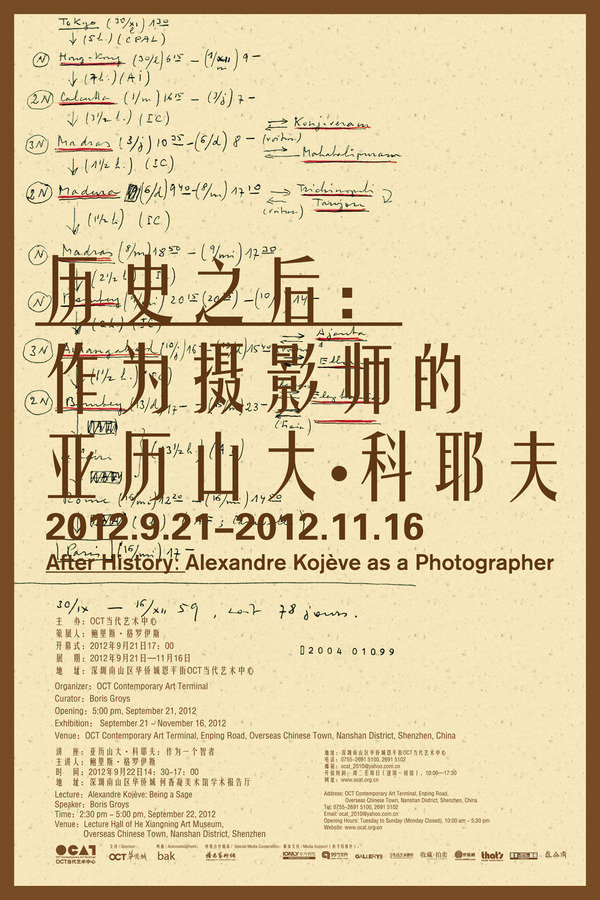After History
dal 20/9/2012 al 15/11/2012
Segnalato da
20/9/2012
After History
OCAT Contemporary Art Terminal, Shenzhen
Alexandre Kojeve as a Photographer. The exhibition includes nearly 400 photographs taken in the 1950s and 1960s, of Russian-born French philosopher and diplomat. Kojeve's influential reinterpretation of philosopher Hegel's writing inspired a generation of French thinkers such as Michel Foucault, Jacques Derrida, and Jacques Lacan.

Curator Boris Groys
From September 21 to November 16, OCT Contemporary Art Terminal (OCAT) will be presenting the research exhibition After History: Alexandre Kojève as a Photographer, curated by philosopher and art critic Boris Groys. This exhibition was on display at BAK, basis voor actuele kunst in Utrecht, the Netherlands between May and July, 2012, before touring to OCAT.
This exhibition for the first time unveils to the Chinese public the unique photographic work, which includes nearly 400 photographs taken in the 1950s and 1960s, of Russian-born French philosopher and diplomat Alexandre Kojève. Kojève also traveled extensively in Ceylon (Sri Lanka), China, India, Iran, Japan, Nepal, the Soviet Union, and throughout Western Europe. His journey and lifetime collection of postcards will be presented at OCAT in a special way. Through this image collection, the essence of both Kojève’s philosophical thinking and his political practice is captured.
Kojève’s influential reinterpretation of philosopher Hegel’s writing inspired a generation of French thinkers such as Michel Foucault, Jacques Derrida, and Jacques Lacan. Kojève thought history ended with the French Revolution, as it had achieved particular individual freedoms and the universal recognition of human desires. This notion of the “end of history” was later famously transformed by political scientist Francis Fukuyama to explain the loss of ideological antagonisms after the fall of the Berlin Wall in 1989. Believing that under the post-historical condition one should stop thinking about the world and instead improve it, Kojève abandoned philosophy to work for the French Ministry of Economic Affairs as a chief planner of the European Common Market, which later became the European Union. Remarkably, after this shift from deliberation to action Kojève started to develop his own obsessive photographic practice in order to register the post-historical world. The many generic postcards he collected show what inspired his artistic style.
The collection of both photographs and postcards portrays the world as Kojève articulated it through his philosophical thinking: an aesthetically harmonious and exotic East; a stiflingly complete and hollow West; and Russia, Kojève’s rapidly changing homeland, is shown mainly through old churches frozen in time. Through its premiere presentation, the thousands of repetitive images in the exhibition visualize a post-historical world awaiting an ideal imaginary of freedom, justice, and equality to be realized through activism. By doing so, it questions the critical capacity for change in our contemporary reality and shows us a global stage anticipating the achievement of another tomorrow.
Related Activities:
2:30pm - 5:00pm, September 22, 2012
Alexandre Kojève: Being a Sage - Lecture by Boris Groys
2pm - 3pm, September 21, 2012
Alexandre Kojève and the “Former West” - Lecture by Gwen Parry
10.30 am - noon, September 22, 2012
Rasheed Araeen in Shenzhen - Lecture by Rasheed Araeen
10.30 am - noon, September 23, 2012
Boris Groys in Conversation with Marko Daniel
Sponsor: Shenzhen Overseas Chinese Town Co., Ltd.
Opening: Friday, September 21, 5pm
OCT Contemporary Art Terminal
Enping Road, Overseas Chinese Town Nanshan District, Shenzhen, China
Hours: Tue–Sun, 10–5:30pm



